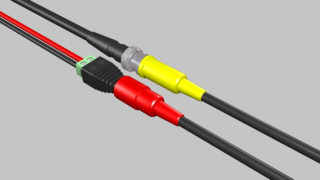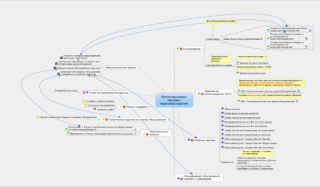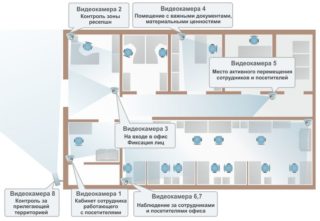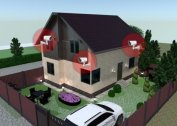Any user is able to organize housing monitoring in an apartment building. To do this, you will have to carefully study the composition of the observational complex, as well as the order of its installation. In addition, it is useful to familiarize yourself with existing types of control systems using cameras.
CCTV elements
Before installing video surveillance in the apartment, you will need to familiarize yourself with the completeness of the system:
- a video camera used to record an image and transfer it to a display and recording device;
- a DVR that receives video information taken from cameras, displays it on a monitor screen, and then saves it in an archive;
- monitor designed to display images;
- typical power supply.
The first of these positions has many designs intended for installation on the street or indoors, as well as equipped with special illumination with infrared rays or without it. By the method of transmitting information, cameras are divided into wired, using a cable connection and wireless (radio channel, WiFi, etc.).
In the simplest case, the registrar is not part of the system (information is recorded on a separate PC, or is dispensed with at all). The monitor is also not a mandatory component of the surveillance complex; instead, it is allowed to use any suitable device: laptop, tablet or mobile phone.
The power supply is a mandatory component used when installing a video surveillance system. He is responsible for the uninterrupted supply of DC voltage to the cameras. In most cases, its value is 12/24 Volts obtained after converting 220 volt network. Correct experts will help you choose the right equipment for installation and installation of video surveillance. An alternative to this solution is to purchase a ready-made kit with suitable characteristics.
In addition to the listed components, you will need:
- cable connecting the recorder to individual cameras - a normal coaxial cable for a TV is suitable;
- BNC connectors guaranteeing a high-quality connection;
- power cable routed to each of the cameras;
- information storage device (for storing video recordings).
The selected drive is installed in the registrar that does not have it in the original configuration.
A power cable for video cameras is required if an antenna analog is used as a signal connector. If you intend to purchase a specialized cable product, a separate power cord is not needed.
Design steps
A properly designed project for the installation of video cameras in a room contains the following items:
- Analysis of the features of the rooms and determination of the initial requirements for the system.
- Preparation of TOR certified and signed by the relevant services.
- Acquisition of system components and subsequent installation.
- Testing in operational and emergency modes.
When preparing the initial data, taking into account the installation of video surveillance, the total number of monitored zones (cameras) is calculated, sufficient to solve the task. At the same stage, their installation locations within the protected premises or territory are determined.When developing the first question, the angle of the cameras is taken into account, which provides the maximum overview of the protected space over its entire area. With an increase in this indicator, the number of survey devices used will increase.
To protect a private house, at least 4 cameras are required, installed in the corners of the building. Mandatory points at which they should be placed during the preparation of the project:
- zone at the entrance to the dwelling;
- space at the entrance to the garage building;
- central gate with a gate;
- problem areas through which attackers can enter the territory.
For the convenience of choosing the points of setting video surveillance, it is recommended to use the site plan. For effective monitoring of private households, they will need from 8 to 16 pieces.
Video Surveillance Methods
In private practice, two main types of cameras are widely used. In the market they are represented by IP or digital survey devices and analog devices. Each of them has its own characteristics.
Analog camera
 This type of overview device is connected to a conventional TV, allowing you to view an analog image. For its subsequent processing and recording on a compact medium, conversion to digital code will be required. To do this, you need a registrar, without which the installation of such a camera loses its meaning.
This type of overview device is connected to a conventional TV, allowing you to view an analog image. For its subsequent processing and recording on a compact medium, conversion to digital code will be required. To do this, you need a registrar, without which the installation of such a camera loses its meaning.
Modern analog devices provide high-quality resolution up to 2 megapixels, capable of transmitting a color image. For its “delivery” to the registrar, a coaxial cable is used, the length of which is limited (no more than 500 meters).
The advantages of such cameras include a relatively low price and ease of setup. Among the shortcomings, limited functionality is noted.
IP camera
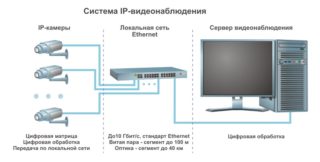 Digital IP cameras do not need to convert the transmitted signal and are more versatile devices compared to analog samples. Their advantages:
Digital IP cameras do not need to convert the transmitted signal and are more versatile devices compared to analog samples. Their advantages:
- the ability to scale the image;
- high resolution (up to 8 megapixels);
- permissibility of storing information in cloud services;
- wireless inclusion, allowing you to get an image anywhere in the world.
IP devices are also not without drawbacks, manifested in their high cost and incompatibility of cameras and recorders from different manufacturers.
When choosing the type of cameras proceed from the conditions of their use. With a significant length of cable routes, preference is given to analog models. If you need to install a limited number of cameras at a short distance from the DVR, it is more convenient to use IP devices.
System Installation Procedure
Upon completion of the selection of cameras, as well as determining their number and installation locations, they proceed directly to the installation. To do this, you need to familiarize yourself with the main stages of the upcoming work.
Cable management
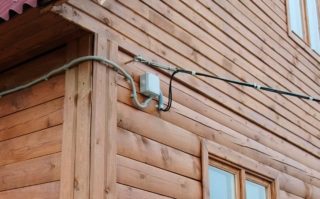
To combine the components of the system, cable products are used that are laid for analog systems based on coaxial connectors. They do not need additional video adapters, the presence of a reliable screen will protect the system from electromagnetic interference.
In digital or IP systems, a “twisted pair” is selected for laying, which is a combination of several paired conductors interlaced in a certain way. Due to this technology, it is possible to reduce the effect of electromagnetic interference on the transmitted signal.
In accordance with safety requirements, the lines of video surveillance systems are laid at a distance of at least 40 cm from power cables. This precaution will help to protect the broadcast signal from distortion by electromagnetic interference.If the specified distance during installation cannot be maintained, the signal cables are placed in a special braid or in a grounded metal hose.
Camera Mounting
Correct installation of video surveillance is impossible without a well-planned distribution of cameras mounted taking into account the complete capture of the protected area and invisibility to violators. In addition, monitoring devices are installed so that, if necessary, access to them was free. To connect analog model samples, you will need a coaxial cable with tulip-type connectors that differ in color.
Red-colored switching contacts are used to connect power, and white and yellow tulips and wires are used to transmit signals. To connect digital video cameras you will need twisted pair cable, two typical RG-45 connectors and the power cable itself.
For outdoor installation, it is recommended to use special fasteners purchased separately from the kit to fix the cameras. In addition, for safety reasons, it is not recommended to mount them on high metal supports. During a thunderstorm, they will turn into a kind of lightning rod and can be damaged.
Installation and connection of the recorder as part of the system
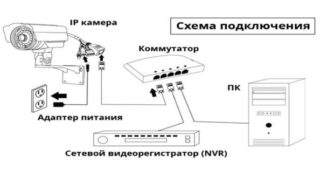 The DVR is one of the most important elements of a surveillance system, during the installation of which the main thing is to correctly connect the existing connectors. It is preferable to use devices with the PoE function, which provides video cameras with the necessary power. Otherwise, you will need to mount a separate cable yourself to supply voltage to the remote devices.
The DVR is one of the most important elements of a surveillance system, during the installation of which the main thing is to correctly connect the existing connectors. It is preferable to use devices with the PoE function, which provides video cameras with the necessary power. Otherwise, you will need to mount a separate cable yourself to supply voltage to the remote devices.
For correct operation of the recorder, eliminating overheating, it is recommended to place it in places with an established ventilation system. If the instrument has a PoE function, it is not necessary to monitor the polarity of the power supply. In models lacking this option, polarity is mandatory. Plug connectors and pads are placed in junction boxes that protect the contacts from oxidation.
Customization
Installation of video surveillance systems is being completed by setting up installed and connected equipment. The procedure at this stage is as follows:
- On each device from the kit, the exact time and date is set, which is important for their binding to fixed events.
- Information storage devices are formatted.
- The parameters for viewing cameras are set by setting the desired tilt and rotation angles.
- After that, you will need to configure the video recording mode. The DVR client application is suitable, allowing you to manage multiple monitoring points from one PC.
At the final stage, the function of remote access to cameras is configured. This is done through cloud services or in the usual way - through the search bar of a browser.
Ways to install video cameras indoors
When choosing a specific installation location for CCTV cameras within the apartment, the following options are possible:
- on a false ceiling;
- on the bracket;
- right on the wall.
In the absence of a false ceiling, the installation of CCTV cameras is carried out using brackets equipped with a rotation mechanism in two planes. In addition, there are mortise chambers placed in specially prepared places.
Special models are represented by samples that allow you to covertly observe the object. When installing video cameras of this type, it should be remembered that under Russian law, secret surveillance of people is considered unlawful.
Typical errors
Erroneous actions possible when installing a burglar alarm and video surveillance:
- inaccuracies in determining the distances from surveillance cameras to recorders, affecting the correct choice of cable type and brand;
- the choice of a cable sample of a greater length than it should be according to the passport - it should not exceed the maximum determining the efficiency of the system;
- improperly selected power source, the power of which should be enough to work with maximum load with all elements of the system turned on;
- incorrectly selected video information storage device.
In the latter case, it is important to correctly calculate the amount of hard disk required for operation. Information storage devices with a capacity of up to 3000 GB, for example, allow you to store the amount of video footage captured within 10-45 days.
Another common mistake when installing the system with your own hands is incorrect installation of cable connectors. During these operations, they try to avoid sharp bends of the cable in the sections of the turn of the route. Failure to do so often leads to damage and system failure. The correct approach to the selection of its components and the absence of other characteristic errors guarantee the achievement of the required system performance.

